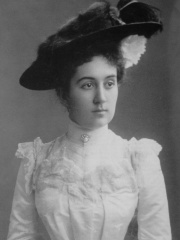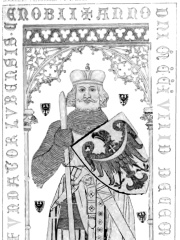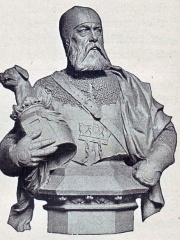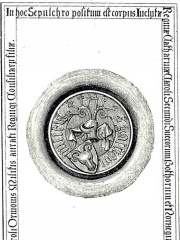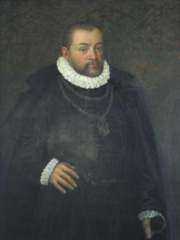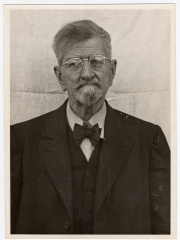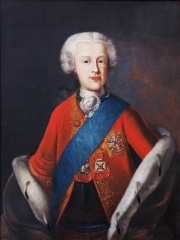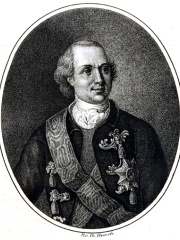NOBLEMAN
John I, Count Palatine of Zweibrücken
1550 - 1604
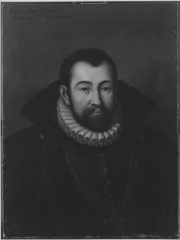
 John I, Count Palatine of Zweibrücken
John I, Count Palatine of Zweibrücken
John I of Zweibrücken (known as the Lame; German: Pfalzgraf Johann I von Zweibrücken; 8 May 1550 – 12 August 1604) was Count Palatine and Duke of Zweibrücken during 1569–1604. Read more on Wikipedia
His biography is available in 17 different languages on Wikipedia. John I, Count Palatine of Zweibrücken is the 754th most popular nobleman (down from 632nd in 2024), the 2,683rd most popular biography from Germany (down from 2,419th in 2019) and the 155th most popular German Nobleman.
Memorability Metrics
Page views of John I, Count Palatine of Zweibrücken by language
Among NOBLEMEN
Among noblemen, John I, Count Palatine of Zweibrücken ranks 754 out of 1,415. Before him are Philippine Welser, Princess Maria Carolina of Savoy, William, Count of Luxembourg, Christian IV, Count Palatine of Zweibrücken, Bogislaw XIV, Duke of Pomerania, and Eric II, Duke of Pomerania. After him are Princess Xenia of Montenegro, Bolesław I the Tall, Princess Margherita of Bourbon-Parma, John II, Burgrave of Nuremberg, Princess Maria Christina of Saxony, and Catherine Karlsdotter.
Most Popular Noblemen in Wikipedia
Go to all RankingsPhilippine Welser
1527 - 1580
HPI: 61.77
Rank: 748
Princess Maria Carolina of Savoy
1764 - 1782
HPI: 61.76
Rank: 749
William, Count of Luxembourg
1081 - 1131
HPI: 61.76
Rank: 750
Christian IV, Count Palatine of Zweibrücken
1722 - 1775
HPI: 61.75
Rank: 751
Bogislaw XIV, Duke of Pomerania
1580 - 1637
HPI: 61.72
Rank: 752
Eric II, Duke of Pomerania
1418 - 1474
HPI: 61.71
Rank: 753
John I, Count Palatine of Zweibrücken
1550 - 1604
HPI: 61.70
Rank: 754
Princess Xenia of Montenegro
1881 - 1960
HPI: 61.67
Rank: 755
Bolesław I the Tall
1127 - 1201
HPI: 61.67
Rank: 756
Princess Margherita of Bourbon-Parma
1847 - 1893
HPI: 61.67
Rank: 757
John II, Burgrave of Nuremberg
1309 - 1357
HPI: 61.66
Rank: 758
Princess Maria Christina of Saxony
1770 - 1851
HPI: 61.64
Rank: 759
Catherine Karlsdotter
1418 - 1450
HPI: 61.64
Rank: 760
Contemporaries
Among people born in 1550, John I, Count Palatine of Zweibrücken ranks 23. Before him are Emilio de' Cavalieri, Chand Bibi, Michael Maestlin, False Dmitry III, Damat Ibrahim Pasha, and Tang Xianzu. After him are Marie Eleonore of Cleves, Francisco Sanches, Abu Abdallah Mohammed II Saadi, Orazio Vecchi, Sokolluzade Lala Mehmed Pasha, and Man Singh I. Among people deceased in 1604, John I, Count Palatine of Zweibrücken ranks 7. Before him are Edward de Vere, 17th Earl of Oxford, Catherine de Bourbon, Fausto Sozzini, Claudio Merulo, Ercole, Lord of Monaco, and Peter Ernst I von Mansfeld-Vorderort. After him are Christine of Hesse, Juan Fernández, Otto Henry, Count Palatine of Sulzbach, Hamida Banu Begum, Louis IV, Landgrave of Hesse-Marburg, and Francesco Barozzi.
Others Born in 1550
Go to all RankingsEmilio de' Cavalieri
COMPOSER
1550 - 1602
HPI: 63.77
Rank: 17
Chand Bibi
POLITICIAN
1550 - 1599
HPI: 63.09
Rank: 18
Michael Maestlin
MATHEMATICIAN
1550 - 1631
HPI: 62.88
Rank: 19
False Dmitry III
POLITICIAN
1550 - 1612
HPI: 62.35
Rank: 20
Damat Ibrahim Pasha
POLITICIAN
1550 - 1601
HPI: 62.28
Rank: 21
Tang Xianzu
WRITER
1550 - 1616
HPI: 61.92
Rank: 22
John I, Count Palatine of Zweibrücken
NOBLEMAN
1550 - 1604
HPI: 61.70
Rank: 23
Marie Eleonore of Cleves
POLITICIAN
1550 - 1608
HPI: 61.69
Rank: 24
Francisco Sanches
PHILOSOPHER
1550 - 1623
HPI: 61.54
Rank: 25
Abu Abdallah Mohammed II Saadi
POLITICIAN
1550 - 1578
HPI: 61.39
Rank: 26
Orazio Vecchi
COMPOSER
1550 - 1605
HPI: 61.33
Rank: 27
Sokolluzade Lala Mehmed Pasha
POLITICIAN
1550 - 1606
HPI: 60.33
Rank: 28
Man Singh I
POLITICIAN
1550 - 1614
HPI: 59.90
Rank: 29
Others Deceased in 1604
Go to all RankingsEdward de Vere, 17th Earl of Oxford
POLITICIAN
1550 - 1604
HPI: 69.79
Rank: 1
Catherine de Bourbon
WRITER
1559 - 1604
HPI: 67.31
Rank: 2
Fausto Sozzini
RELIGIOUS FIGURE
1539 - 1604
HPI: 66.01
Rank: 3
Claudio Merulo
COMPOSER
1533 - 1604
HPI: 64.05
Rank: 4
Ercole, Lord of Monaco
POLITICIAN
1562 - 1604
HPI: 63.35
Rank: 5
Peter Ernst I von Mansfeld-Vorderort
POLITICIAN
1517 - 1604
HPI: 61.90
Rank: 6
John I, Count Palatine of Zweibrücken
NOBLEMAN
1550 - 1604
HPI: 61.70
Rank: 7
Christine of Hesse
POLITICIAN
1543 - 1604
HPI: 61.63
Rank: 8
Juan Fernández
EXPLORER
1536 - 1604
HPI: 60.51
Rank: 9
Otto Henry, Count Palatine of Sulzbach
POLITICIAN
1556 - 1604
HPI: 60.43
Rank: 10
Hamida Banu Begum
COMPANION
1527 - 1604
HPI: 59.65
Rank: 11
Louis IV, Landgrave of Hesse-Marburg
NOBLEMAN
1537 - 1604
HPI: 59.43
Rank: 12
Francesco Barozzi
MATHEMATICIAN
1537 - 1604
HPI: 59.21
Rank: 13
In Germany
Among people born in Germany, John I, Count Palatine of Zweibrücken ranks 2,684 out of 7,253. Before him are Princess Friederike Luise of Prussia (1714), Heinrich Boie (1794), Walter Ruttmann (1887), Claus Schilling (1871), Eric II, Duke of Pomerania (1418), and Ernest Augustus II, Duke of Saxe-Weimar-Eisenach (1737). After him are Prince Georg Ludwig of Holstein-Gottorp (1719), Dietmar Hopp (1940), Christine of Saxony (1505), Wilhelm Leibl (1844), Henny Porten (1890), and Georg Joseph Vogler (1749).
Others born in Germany
Go to all RankingsPrincess Friederike Luise of Prussia
POLITICIAN
1714 - 1784
HPI: 61.71
Rank: 2,678
Heinrich Boie
BIOLOGIST
1794 - 1827
HPI: 61.71
Rank: 2,679
Walter Ruttmann
FILM DIRECTOR
1887 - 1941
HPI: 61.71
Rank: 2,680
Claus Schilling
PHYSICIAN
1871 - 1946
HPI: 61.71
Rank: 2,681
Eric II, Duke of Pomerania
NOBLEMAN
1418 - 1474
HPI: 61.71
Rank: 2,682
Ernest Augustus II, Duke of Saxe-Weimar-Eisenach
POLITICIAN
1737 - 1758
HPI: 61.70
Rank: 2,683
John I, Count Palatine of Zweibrücken
NOBLEMAN
1550 - 1604
HPI: 61.70
Rank: 2,684
Prince Georg Ludwig of Holstein-Gottorp
POLITICIAN
1719 - 1763
HPI: 61.70
Rank: 2,685
Dietmar Hopp
BUSINESSPERSON
1940 - Present
HPI: 61.70
Rank: 2,686
Christine of Saxony
POLITICIAN
1505 - 1549
HPI: 61.69
Rank: 2,687
Wilhelm Leibl
PAINTER
1844 - 1900
HPI: 61.69
Rank: 2,688
Henny Porten
ACTOR
1890 - 1960
HPI: 61.69
Rank: 2,689
Georg Joseph Vogler
COMPOSER
1749 - 1814
HPI: 61.69
Rank: 2,690
Among NOBLEMEN In Germany
Among noblemen born in Germany, John I, Count Palatine of Zweibrücken ranks 155. Before him are Elisabeth of Anhalt-Zerbst (1563), Princess Dorothea Wilhelmine of Saxe-Zeitz (1691), Friedrich Josias, Prince of Saxe-Coburg and Gotha (1918), Philippine Welser (1527), Bogislaw XIV, Duke of Pomerania (1580), and Eric II, Duke of Pomerania (1418). After him are Princess Maria Christina of Saxony (1770), William Ernest, Duke of Saxe-Weimar (1662), Princess Magdalena Augusta of Anhalt-Zerbst (1679), Charlotte von Stein (1742), Johann Leopold, Hereditary Prince of Saxe-Coburg and Gotha (1906), and Countess Amalie Elisabeth of Hanau-Münzenberg (1602).
Elisabeth of Anhalt-Zerbst
1563 - 1607
HPI: 61.94
Rank: 149
Princess Dorothea Wilhelmine of Saxe-Zeitz
1691 - 1743
HPI: 61.93
Rank: 150
Friedrich Josias, Prince of Saxe-Coburg and Gotha
1918 - 1998
HPI: 61.81
Rank: 151
Philippine Welser
1527 - 1580
HPI: 61.77
Rank: 152
Bogislaw XIV, Duke of Pomerania
1580 - 1637
HPI: 61.72
Rank: 153
Eric II, Duke of Pomerania
1418 - 1474
HPI: 61.71
Rank: 154
John I, Count Palatine of Zweibrücken
1550 - 1604
HPI: 61.70
Rank: 155
Princess Maria Christina of Saxony
1770 - 1851
HPI: 61.64
Rank: 156
William Ernest, Duke of Saxe-Weimar
1662 - 1728
HPI: 61.63
Rank: 157
Princess Magdalena Augusta of Anhalt-Zerbst
1679 - 1740
HPI: 61.61
Rank: 158
Charlotte von Stein
1742 - 1827
HPI: 61.60
Rank: 159
Johann Leopold, Hereditary Prince of Saxe-Coburg and Gotha
1906 - 1972
HPI: 61.52
Rank: 160
Countess Amalie Elisabeth of Hanau-Münzenberg
1602 - 1651
HPI: 61.46
Rank: 161






